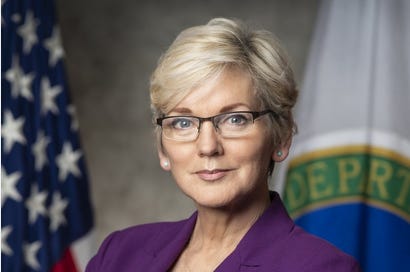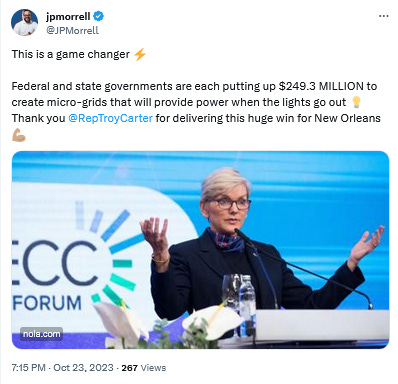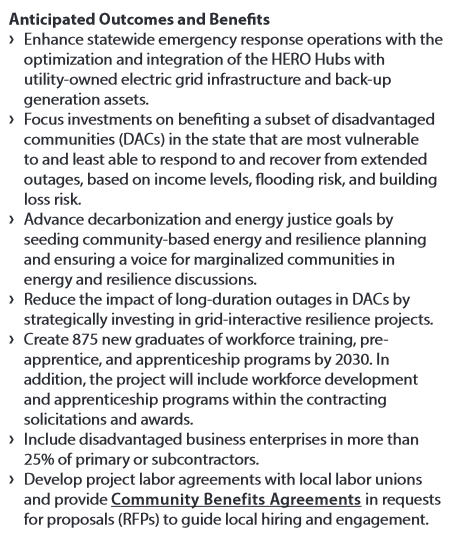$498,658,966 For A Multi-Stakeholder Coordination Framework
Drips and drops of solar panel power for small clusters in some places
[NOTE: This article could be too long to be fully visible in email. Click on the article title to leave email and enter the Substack website. Download the app and get the best experience reading Substack.]
“A Game Changer”
New Orleans City Council President JP Morrell is so consistently wrong about so many things that when I saw this post from him on Twitter, I had to look into it:
And when I saw agreement from a fellow City Council member, I felt certain something was amiss:
I cocked my head to one side…
$249,329,483 + $249,329,483 = $498,658,966
$498,658,966 for WHAT?
For micro grids
Electricity production in such small amounts, and distribution to so few, as to be “micro”
You are not misreading that; you are not misunderstanding that; I am not misstating that.
This might be the most expensive residential power ever produced in the United States.
$1,329,243 to spend on each of 375 planned grids.
“Micro grids” (or, clumsily, “microgrids”) to supply power to a limited number of homes when the state’s grid shuts down.
Imagine living next door to the last house on the line.
(That’s the public face of the program, but we’ll look at the real beneficiaries in a moment.)
Keep in mind as you read this article that for $498,658,966 the state and federal governments could purchase and give away 1,184,491 of these 4,000 watt generators (without assuming any discount for bulk purchase.)
Just sayin’
The US Census Bureau lists 1,748,688 households in the state.
Nearly every household in Louisiana could receive, at no cost, a 4,000 watt generator for the price of drips and drops of solar panel power distributed to small clusters of people after a storm.
From The Advocate:
Even when they live far from the eye of a hurricane, Louisiana residents can often go days, even weeks, without lights and air conditioning while food thaws in unpowered freezers.
Utility companies say hardening the lines and keeping the power on after a storm is a huge expense – one that Louisiana homeowners and businesses ultimately would have to pay for each month in the form of higher bills.
So, Louisiana will be trying something a little different: creating what they call “microgrids“ in 375 communities, an effort that the federal government is helping to cover, U.S. Secretary of Energy Jennifer M. Granholm and U.S. Rep. Troy Carter, D-New Orleans, said Monday. The idea is to set up solar panels and battery arrays that can generate electricity for a neighborhood whenever the power is knocked out.
Can we take bets now that 375 of these will never get built? And what are they, actually? Something trucked in after a storm to places hardest hit? Or something built now, in pre-selected locations?
Also… A storm tough enough to shut down “the bigger grid” won’t rip solar panels apart? Is this another “Tow the windmills into port ahead of a hurricane” fantasy?
Yes, it is…
“It allows a particular community, could be a small subset of a community, could be 20 homes, could be 200 homes, generally, to disconnect from the bigger grid when the bigger grid goes down,” Granholm said. The community will then “have backup power, could be solar power combined with battery storage. Microgrids often have both solar and battery because that's the least expensive and the most readily accessible.”
Energy Secretary Granholm is not at all the brightest bulb in the pack:
I have to admit that I questioned if Louisiana is actually spending so much money, but, yes…
What is all this wasted money and foolishness about?
In truth, there’s a mix of players with distinct motivations at work here:
A congregation of New Orleans nuns dedicated to providing power to people living in poverty. (While I doubt the efficacy of their program, I don’t deny the program may very well be a help to some. I trust the nuns’ motivations, “woke” as they may be.)
An advocacy group that assembles around issues.
The Biden Administration’s Energy Department under Jennifer Granholm.
“Energy Justice”
The Sisters of the Holy Family are all-in regarding power and poverty. I credit them fully for expressing their mission as they do. I don’t doubt the sisters, but I do doubt solar as the best means to help. I doubt that these micro grids will have the beneficial impact the sisters hope; I’d be delighted to be proven wrong.
From only last month, as reported in the Clarion Herald:
Sister Alicia Costa, congregational leader of the Sisters of the Holy Family, received a surprising, yet wonderful call recently from Broderick Bagert Jr., an organizer of the faith- and community-based Together New Orleans.
Bagert was inviting her to meet with Pope Francis at the Vatican Sept. 14 as part of the Industrial Areas Foundation’s (IAF) 15-member contingent. They were the only members from Together New Orleans, an affiliate of the statewide Together Louisiana that aligns with IAF, a network of faith- and community-based organizations that builds leadership development to create citizen-led action.
Together New Orleans has concentrated on providing a consistent and affordable energy source for the vulnerable, a segment of the population that the Sisters of the Holy Family have cared for since their founding in 1842. The sisters’ support of Together New Orleans’ efforts was why Bagert said he invited her.
The sisters and I are in different places on this, but… okay. They’re serving their people! I do not doubt their goals, but the means to their goals. (I’m not rooting against you, Sister Alicia!)
She, Bagert and Mother Minerva Camarena Skeith, an Episcopalian minister from Austin, spoke on the climate, mentioning how Texas and Louisiana are not only affected by climate change but also contribute to its destruction with carbon emissions from petrochemical plants.
The sisters understand that people need electrical power to flourish! Ok…
Sister Alicia [told the pope] “Your encyclical ‘Laudato Si’ was powerful and important for us. You are telling us it is a moral obligation to address environmental issues. IAF has made it possible for us TO BUILD THE POLITICAL POWER WE NEED to act on that call. We are working to have 500 churches become ‘community lighthouses’ with solar panels and battery storage to serve their neighborhoods after disasters. And, imagine this. Our congregation is building its own solar farm on vacant land to lower electric bills of poor families.”
The Advocate covered this event, too.
Two leaders of the Together Louisiana movement for social change met with Pope Francis at the Vatican on Thursday.
They used a 75-minute meeting to tout the nonprofit’s Community Lighthouse program installing solar panels on churches and other community centers.
“He gave us a big thumbs-up,” Sister Alicia Costa, superior of the Sisters of the Holy Family congregation in New Orleans, said after the meeting.
“Literally,” laughed Together Louisiana organizer Broderick Bagert.
And Together Louisiana is “an organization of organizations” …
From The Advocate
Together Baton Rouge [Together Louisiana] is often … bringing together a broad, often unlikely, mix of community members and groups to tackle a common goal.
In the group's 13-year history, it's taken on everything from closed bridges in underserved communities to powerful industrial tax exemptions. If the group identifies something that can help the community, no issue too large or too small is off the table.
While the group formed in 2010, its beginnings stretch back to 2008 when a coalition of Black pastors began discussing ways to tackle social issues in Baton Rouge. Fairly quickly, they realized that in order to effect deep change, reaching out to different sections of the community would be crucial.
“It was clear to us early on that if we were going to have an impact on the community of Baton Rouge, it could not just be a handful of African American pastors," the late Rev. Lee Wesley said at the time. "It had to be a cross section of people across the city and the parish."
Their approach, formulated during that time, comes down to three basic goals: relationship building, equipping members with the skills needed to get results, and a focus on achieving change with concrete issues.
These combined forces got it done, the Democrat Biden Administration being robust advocates, allied and aligned, “doing the work” through the “renewables” / solar + wind + battery / Green New Deal Agenda.
The “justice” angle and the nuns are the cherries on top!
You’ll find all the Democrat Party’s favorite words:
Investment in a subset of disadvantaged communities
Advance decarbonization and energy justice goals by seeding community-based energy and resilience planning and ensuring a voice for marginalized communities
+25% of contracts to disadvantaged business enterprises
Develop project labor agreements with labor unions
Combined governments are spending half a billion dollars on a multi-stakeholder coordination framework.
It’s a mouthful:
The State of Louisiana will launch a strategic energy resilience initiative, Hubs for Energy Resilient Operations - HERO - to establish a foundational approach for accelerating more abundant, affordable, and reliable clean energy for greater power resilience in the face of rising extreme weather and more frequent natural disasters. HERO unites the public, private, and philanthropic sectors by applying a multi-stakeholder coordination framework with a common set of objectives and shared commitments to help solve energy security challenges and protect the residents of Louisiana from climate-related threats. The project will deploy a comprehensive, data-driven integrated community energy planning process as well as a modernized network of Community Resilience Hubs powered by distributed energy resources microgrids.
Just like that, the nuns got $498,658,966 to make power plants of churches.
And you will not have this:
the bec
Floating Wind Turbines In the Gulf Will Be "Towed Into Port" Ahead of Hurricanes
Less than a year ago, The Advocate/nola.com ran a series of five articles on the upcoming development of wind farms in the Gulf of Mexico, off the coasts of Louisiana and Texas. Authored by Environment Reporter Tristan Baurick, the newspaper could not be more aglow about the project; it is as if God’s Angels themselves carry these massive towers to site on their sacred wing, lowering them into place with the precision of the Maker Himself.
So If Not Solar/Wind/Battery, What?
Let’s begin at the end, the end of one of the bec’s most-read posts: The ultimate question about this entire project remained not only unasked but unimagined: Why are any wind farms needed in the Gulf of Mexico when the intermittent, unreliable, and expensive energy they produce, along with damage to the Gulf itself, are all replaceable and avoidable by simply constructing a Small Modular Reactor nuclear power station, providing constant, low-cost, reliable electricity to the Gulf Coast?

















Reality Check: Engineering
By design interconnected systems (grids) share faults and hazards.
Intense weather events present faults and hazards to electrical supply/distribution systems.
Clearing faults and hazards requires human and other limited resources.
Adding multiple intermittently active power sources to an already overstressed distribution system will create safety and fiscal nightmares for those responsible for maintaining/operating distribution systems.
This is yet another $500MM purchase of self-congratulations and window dressing that will not achieve it purported goal.